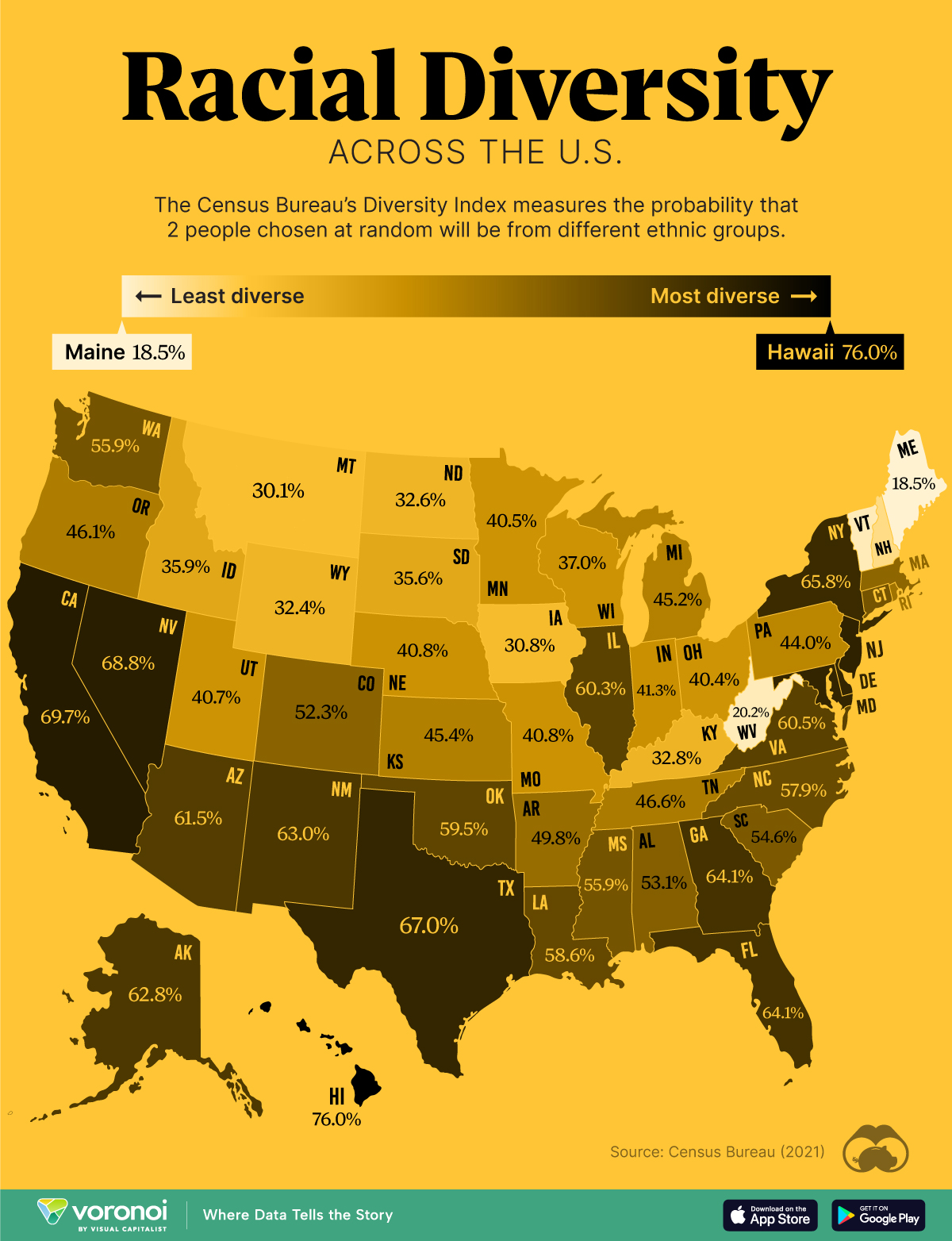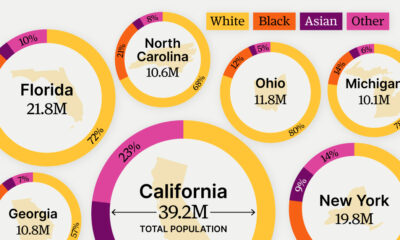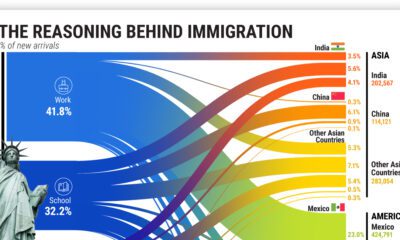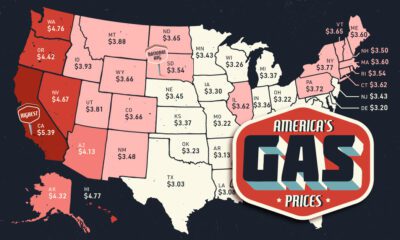Demographics
Mapped: Racial Diversity by U.S. State
![]() See this visualization first on the Voronoi app.
See this visualization first on the Voronoi app.
The Most Diverse States in the U.S.
This was originally posted on our Voronoi app. Download the app for free on iOS or Android and discover incredible data-driven charts from a variety of trusted sources.
As of 2020, there was a 61.1% likelihood that two people chosen at random will be from different ethnicities in America.
This number comes from the Census Bureau’s Diversity Index, which ranges from 0% to 100% per jurisdiction. A value closer to 0% means that a population is more homogenous, while 100% means that a population has more racial diversity.
This graphic maps the most diverse states in the U.S., based on the most recently available data.
Racial Diversity Across U.S. States
Below, we rank states based on their Diversity Index score in 2020. Each score represents the probability that two people chosen at random will be of different racial or ethnic backgrounds:
| Rank | State | Diversity Index (%) |
|---|---|---|
| 1 | Hawaii | 76.0 |
| 2 | California | 69.7 |
| 3 | Nevada | 68.8 |
| 4 | Maryland | 67.3 |
| 5 | Washington, D.C. | 67.2 |
| 6 | Texas | 67.0 |
| 7 | New Jersey | 65.8 |
| 8 | New York | 65.8 |
| 9 | Georgia | 64.1 |
| 10 | Florida | 64.1 |
| 11 | New Mexico | 63 |
| 12 | Alaska | 62.8 |
| 13 | Arizona | 61.5 |
| 14 | Virginia | 60.5 |
| 15 | Illinois | 60.3 |
| 16 | Delaware | 59.6 |
| 17 | Oklahoma | 59.5 |
| 18 | Louisiana | 58.6 |
| 19 | North Carolina | 57.9 |
| 20 | Washington | 55.9 |
| 21 | Mississippi | 55.9 |
| 22 | Connecticut | 55.7 |
| 23 | South Carolina | 54.6 |
| 24 | Alabama | 53.1 |
| 25 | Colorado | 52.3 |
| 26 | Massachusetts | 51.6 |
| 27 | Arkansas | 49.8 |
| 28 | Rhode Island | 49.4 |
| 29 | Tennessee | 46.6 |
| 30 | Oregon | 46.1 |
| 31 | Kansas | 45.4 |
| 32 | Michigan | 45.2 |
| 33 | Pennsylvania | 44 |
| 34 | Indiana | 41.3 |
| 35 | Nebraska | 40.8 |
| 36 | Missouri | 40.8 |
| 37 | Utah | 40.7 |
| 38 | Minnesota | 40.5 |
| 39 | Ohio | 40.4 |
| 40 | Wisconsin | 37 |
| 41 | Idaho | 35.9 |
| 42 | South Dakota | 35.6 |
| 43 | Kentucky | 32.8 |
| 44 | North Dakota | 32.6 |
| 45 | Wyoming | 32.4 |
| 46 | Iowa | 30.8 |
| 47 | Montana | 30.1 |
| 48 | New Hampshire | 23.6 |
| 49 | Vermont | 20.2 |
| 50 | West Virginia | 20.2 |
| 51 | Maine | 18.5 |
In Hawaii, the most diverse U.S. state, 44% of marriages are interracial. Overall, the Hawaiian population is 36.5% Asian, 21.5% white, 10.2% Native Hawaiian or Pacific, and 9.5% Latino or Hispanic.
Meanwhile, California ranks as the second most-diverse state in the country. As the largest ethnic population in the state, Hispanics and Latinos make up 39.4% of residents, followed by 34.7% white, and 15.1% Asian.
In terms of counties, the Aleutians East Borough in Alaska is the most diverse in the country. The least diverse state is Maine, and it also ranks as the oldest state in the country by median age.
Diversity in America, meanwhile, has increased roughly 6% according to the Diversity Index since 2010.
Demographics
The Countries That Have Become Sadder Since 2010
Tracking Gallup survey data for more than a decade reveals some countries are witnessing big happiness declines, reflecting their shifting socio-economic conditions.

The Countries That Have Become Sadder Since 2010
This was originally posted on our Voronoi app. Download the app for free on iOS or Android and discover incredible data-driven charts from a variety of trusted sources.
Can happiness be quantified?
Some approaches that try to answer this question make a distinction between two differing components of happiness: a daily experience part, and a more general life evaluation (which includes how people think about their life as a whole).
The World Happiness Report—first launched in 2012—has been making a serious go at quantifying happiness, by examining Gallup poll data that asks respondents in nearly every country to evaluate their life on a 0–10 scale. From this they extrapolate a single “happiness score” out of 10 to compare how happy (or unhappy) countries are.
More than a decade later, the 2024 World Happiness Report continues the mission. Its latest findings also include how some countries have become sadder in the intervening years.
Which Countries Have Become Unhappier Since 2010?
Afghanistan is the unhappiest country in the world right now, and is also 60% unhappier than over a decade ago, indicating how much life has worsened since 2010.
In 2021, the Taliban officially returned to power in Afghanistan, after nearly two decades of American occupation in the country. The Islamic fundamentalist group has made life harder, especially for women, who are restricted from pursuing higher education, travel, and work.
On a broader scale, the Afghan economy has suffered post-Taliban takeover, with various consequent effects: mass unemployment, a drop in income, malnutrition, and a crumbling healthcare system.
| Rank | Country | Happiness Score Loss (2010–24) | 2024 Happiness Score (out of 10) |
|---|---|---|---|
| 1 | 🇦🇫 Afghanistan | -2.6 | 1.7 |
| 2 | 🇱🇧 Lebanon | -2.3 | 2.7 |
| 3 | 🇯🇴 Jordan | -1.5 | 4.2 |
| 4 | 🇻🇪 Venezuela | -1.3 | 5.6 |
| 5 | 🇲🇼 Malawi | -1.2 | 3.4 |
| 6 | 🇿🇲 Zambia | -1.2 | 3.5 |
| 7 | 🇧🇼 Botswana | -1.2 | 3.4 |
| 8 | 🇾🇪 Yemen | -1.0 | 3.6 |
| 9 | 🇪🇬 Egypt | -1.0 | 4.0 |
| 10 | 🇮🇳 India | -0.9 | 4.1 |
| 11 | 🇧🇩 Bangladesh | -0.9 | 3.9 |
| 12 | 🇨🇩 DRC | -0.7 | 3.3 |
| 13 | 🇹🇳 Tunisia | -0.7 | 4.4 |
| 14 | 🇨🇦 Canada | -0.6 | 6.9 |
| 15 | 🇺🇸 U.S. | -0.6 | 6.7 |
| 16 | 🇨🇴 Colombia | -0.5 | 5.7 |
| 17 | 🇵🇦 Panama | -0.5 | 6.4 |
| 18 | 🇵🇰 Pakistan | -0.5 | 4.7 |
| 19 | 🇿🇼 Zimbabwe | -0.5 | 3.3 |
| 20 | 🇮🇪 Ireland | -0.5 | 6.8 |
| N/A | 🌍 World | +0.1 | 5.5 |
Nine countries in total saw their happiness score drop by a full point or more, on the 0–10 scale.
Noticeably, many of them have seen years of social and economic upheaval. Lebanon, for example, has been grappling with decades of corruption, and a severe liquidity crisis since 2019 that has resulted in a banking system collapse, sending poverty levels skyrocketing.
In Jordan, unprecedented population growth—from refugees leaving Iraq and Syria—has aggravated unemployment rates. A somewhat abrupt change in the line of succession has also raised concerns about political stability in the country.
-

 Education1 week ago
Education1 week agoHow Hard Is It to Get Into an Ivy League School?
-

 Technology2 weeks ago
Technology2 weeks agoRanked: Semiconductor Companies by Industry Revenue Share
-

 Markets2 weeks ago
Markets2 weeks agoRanked: The World’s Top Flight Routes, by Revenue
-

 Demographics2 weeks ago
Demographics2 weeks agoPopulation Projections: The World’s 6 Largest Countries in 2075
-

 Markets2 weeks ago
Markets2 weeks agoThe Top 10 States by Real GDP Growth in 2023
-

 Demographics2 weeks ago
Demographics2 weeks agoThe Smallest Gender Wage Gaps in OECD Countries
-

 Economy2 weeks ago
Economy2 weeks agoWhere U.S. Inflation Hit the Hardest in March 2024
-

 Environment2 weeks ago
Environment2 weeks agoTop Countries By Forest Growth Since 2001














